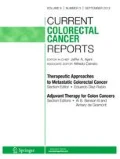Abstract
It was previously though that adenomas gave rise to colorectal cancers and that other polyps were harmless. Serrated polyps—hyperplastic polyps, serrated adenomas, and sessile serrated adenomas—show distinct patterns of genetic and epigentic mutation that suggest their role in an alternative pathway of colorectal cancer development. In parallel with these findings are improved demographic and histologic data that also indicate that a subset of serrated polyps are precursors of cancer.
Similar content being viewed by others
References and Recommended Reading
Vogelstein B, Fearon ER, Hamilton SR, et al.: Genetic alterations during colorectal-tumor development. N Engl J Med 1988, 319:525–532.
Paspatis GA, Papanikolaou N, Zois E, Michalodimitrakis E: Prevalence of polyps and diverticulosis of the large bowel in the Cretan population Int J Colorectal Dis 2001, 16:257–261.
Johannsen LG, Momsen O, Jacobsen NO: Polyps of the large intestine in Aarhus, Denmark. An autopsy study. Scand J Gastroenterol 1989, 24:799–806.
Lee YS: Adenomas, metaplastic polyps and other lesions of the large bowel: an autopsy survey. Ann Acad Med Singapore 1987, 16:412–420.
Tsai CJ, Lu DK: Small colorectal polyps: histopathology and clinical significance. Am J Gastroenterol 1995, 90:988–994.
Brosseuk D, Oosthuizen J, Pinchbeck M: Initial experience with a general population colorectal cancer screening clinic. Am J Surg 2006, 191:669–672.
Olsen RO, Davis WC: Villous adenomas of the colon. Benign or malignant? Arch Surg 1968, 98:487–492.
Rubio CA: Colorectal adenomas: time for reappraisal. Pathol Res Pract 2002, 198:615–620.
Bariol C, Hawkins NJ, Turner JJ, et al.: Histopathological and clinical evaluation of serrated adenomas of the colon and rectum. Mod Pathol 2003, 16:417–423.
Urbanski SJ, Kossakowska AE, Marcon N, Bruce WR: Mixed hyperplastic adenomatous polyps—an underdiagnosed entity. Report of a case of adenocarcinoma arising within a mixed hyperplastic adenomatous polyp. Am J Surg Pathol 1984, 8:551–556.
Longacre TA, Fenoglio-Preiser CM: Mixed hyperplastic adenomatous polyps/serrated adenomas. A distinct form of colorectal neoplasia. Am J Surg Pathol 1990, 14:524–537.
Burt R, Jass J: Hyperplastic polyposis. In WHO International Classification of Tumours, edn 3. Edited by Hamilton SR and Aaltonen LA. Lyon: IARC Press; 2000:135–136.
Torlakovic E, Snover DC: Serrated adenomatous polyposis in humans. Gastroenterology 1996, 110:748–755.
Torlakovic E, Skovlund E, Snover DC, et al.: Morphologic reappraisal of serrated colorectal polyps. Am J Surg Pathol 2003, 27:65–81.
Goldstein NS, Bhanot P, Odish E, Hunter S: Hyperplastic-like colon polyps that preceded microsatellite-unstable adenocarcinomas. Am J Clin Pathol 2003, 119:778–796.
Lazarus R, Junttila OE, Karttunen TJ, Makinen MJ: The risk of metachronous neoplasia in patients with serrated adenoma. Am J Clin Pathol 2005, 123:349–359.
Tung SY, Wu CS, Su MY: Magnifying colonoscopy in differentiating neoplastic from nonneoplastic colorectal lesions. Am J Gastroenterol 2001, 96:2628–2632.
Higuchi T, Sugihara K, Jass JR: Demographic and pathological characteristics of serrated polyps of colorectum. Histopathology 2005, 47:32–40.
Johnson DA, Gurney MS, Volpe RJ, et al.: A prospective study of the prevalence of colonic neoplasms in asymptomatic patients with an age-related risk. Am J Gastroenterol 1990, 85:969–974.
Imperiale TF, Wagner DR, Lin CY, et al.: Results of screening colonoscopy among persons 40 to 49 years of age. N Engl J Med 2002, 346:1781–1785.
Williams AR, Balasooriya BA, Day DW: Polyps and cancer of the large bowel: a necropsy study in Liverpool. Gut 1982, 23:835–842.
Kearney J, Giovannucci E, Rimm EB, et al.: Diet, alcohol, and smoking and the occurrence of hyperplastic polyps of the colon and rectum (United States). Cancer Causes Control 1995, 6:45–56.
Martinez ME, McPherson RS, Levin B, Glober GA: A case-control study of dietary intake and other lifestyle risk factors for hyperplastic polyps. Gastroenterology 1997, 113:423–429.
Morimoto LM, Newcomb PA, Ulrich CM, et al.: Risk factors for hyperplastic and adenomatous polyps: evidence for malignant potential? Cancer Epidemiol Biomarkers Prev 2002, 11:1012–1018.
Nakayama T, Morishita T, Kamiya T: Adenomatous polyposis coli gene as a gatekeeper. Rev Gastroenterol Peru 2002, 22:164–167.
Goldstein NS: Serrated pathway and APC (conventional)-type colorectal polyps: molecular-morphologic correlations, genetic pathways, and implications for classification. Am J Clin Pathol 2006, 125:146–153.
Choi SW, Lee KJ, Bae YA, et al.: Genetic classification of colorectal cancer based on chromosomal loss and microsat-ellite instability predicts survival. Clin Cancer Res 2002, 8:2311–2322.
Bird AP: CpG-rich islands and the function of DNA methylation. Nature 1986, 321:209–213.
Toyota M, Ohe-Toyota M, Ahuja N, Issa JP: Distinct genetic profiles in colorectal tumors with or without the CpG island methylator phenotype. Proc Natl Acad Sci U S A 2000, 97:710–715.
Rashid A, Shen L, Morris JS, et al.: CpG island methylation in colorectal adenomas. Am J Pathol 2001, 159:1129–1135.
Iino H, Jass JR, Simms LA, et al.: DNA microsatellite instability in hyperplastic polyps, serrated adenomas, and mixed polyps: a mild mutator pathway for colorectal cancer? J Clin Pathol 1999, 52:5–9.
Hawkins NJ, Ward RL: Sporadic colorectal cancers with microsatellite instability and their possible origin in hyperplastic polyps and serrated adenomas. J Natl Cancer Inst 2001, 93:1307–1313.
Wynter CV, Walsh MD, Higuchi T, et al.: Methylation patterns define two types of hyperplastic polyp associated with colorectal cancer. Gut 2004, 53:573–580.
Kambara T, Simms LA, Whitehall VL, et al.: BRAF mutation is associated with DNA methylation in serrated polyps and cancers of the colorectum. Gut 2004, 53:1137–1144.
O’Brien MJ, Yang S, Clebanoff JL, et al.: Hyperplastic (serrated) polyps of the colorectum: relationship of CpG island methylator phenotype and K-ras mutation to location and histologic subtype. Am J Surg Pathol 2004, 28:423–434.
Jass JR, Baker K, Zlobec I, et al.: Advanced colorectal polyps with the molecular and morphological features of serrated polyps and adenomas: concept of a ‘fusion’ pathway to colorectal cancer. Histopathology 2006, 49:121–131.
Cairns S, Scholefield JH: Guidelines for colorectal cancer screening in high risk groups. Gut 2002, 51(Suppl 5):V6–9.
Author information
Authors and Affiliations
Corresponding author
Rights and permissions
About this article
Cite this article
Watson, A.R., Jankowski, J. Hyperplastic polyps, serrated adenomas, and the serrated polyp neoplasia pathway. Curr colorectal cancer rep 3, 3–9 (2007). https://doi.org/10.1007/s11888-007-0009-3
Published:
Issue Date:
DOI: https://doi.org/10.1007/s11888-007-0009-3




